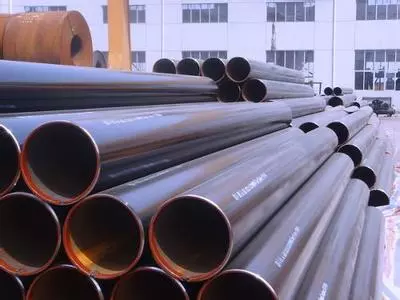High-frequency pipe has many problems among which opening and crack are the two common ones. This artcile introduces about the two problems and its relevant solutions.
1.Opening
(1) Characteristics
Crack openings > = 0.4 mm. Welded joint is straight. Plate edge end face without melting trace or with melting trace is not welded. Both ends of cracks are very pointed and extend along the weld direction. Leak seriously when testing water pressure.
(2) Causes
1) The blank width is less than the negative tolerance, so high-frequency steel tubes can not be welded.
2) Roller bearing is damaged which results in insufficient pressure.
3) The heat output is not enough, and the welding temperature is too low.
(3) Methods of prevention
1) Check frequently strip steel geometric dimension. It is prohibited to use strip steel with ultra width and negative deviation.
2) High frequency heat output and welding speed should be matched properly.
3) Check whether the roller bearing is damaged or not. Change it timely to guarantee the roller enough pressure if the roller bearing has losses.
2. Crack
(1) Characteristics
Water penetration crack: crack width < 0.4 mm. The crack has caking traces. Spray with the shape of mist or leak when testing water pressure.
Micro-crack crack: outer surface has visible microgrooves, and the inner surface is in good condition. There is no leakage phenomenon when testing pressure but it is crazed if being crushed or cold bending.
(2) Causes
1) Low welding temperature (insufficient heat output, and fast welding speed).
2) Roller bearing loss or small strip cause insufficient extrusion force.
3) The sixth and seventh piece of guide roller blade are damaged, and crush the strip steel edge.
4) Strip steel edges have inclusions and its state of edge is unstable.
5) The roll adjustment is improper causing the edge drawing.
6) Weld reverse and uneven heating temperature of two edges.
7) Core rod is being taken away or its burning loss loses efficacy.
8) Two belt sides present pointed peach shape, and quantity of heat focuses on the inner surface. Heat temperature is too high.
(3) Methods of prevention
1) The choice of welding speed and high frequency heat output should be appropriate.
2) Change the guide ring in time if damaged, and it is not allowed to work in the state of breakdown.
3) Check the strip edge condition before feeding, and it shall not be used if there is any breakage, interlayer, etc.
4) Check frequently whether the core rod position is often appropriate or not, whether break away or not and whether drainage systems are in good condition or not.
5) Correctly adjust molding parts in order to prevent edge drawing and
pipe seam reverse.
6) Choose reasonably welding speed and strive to seek stability.

